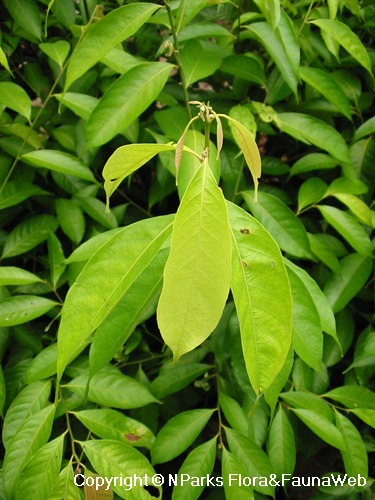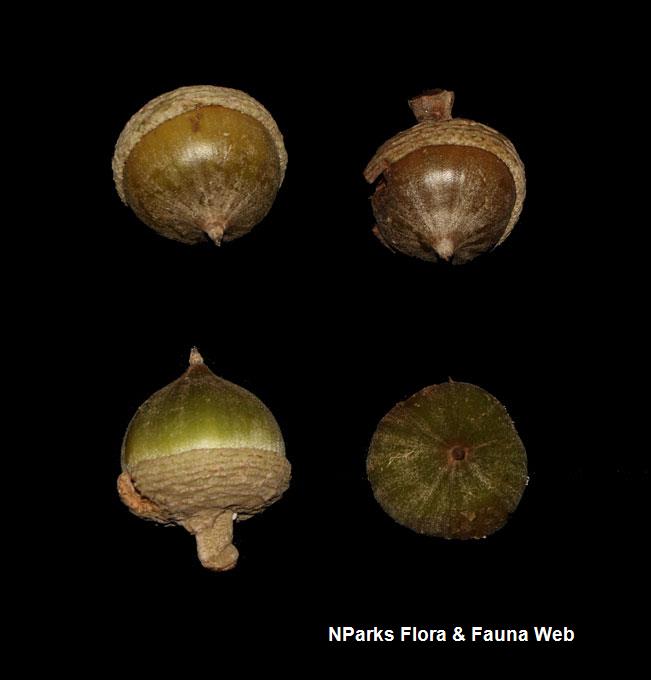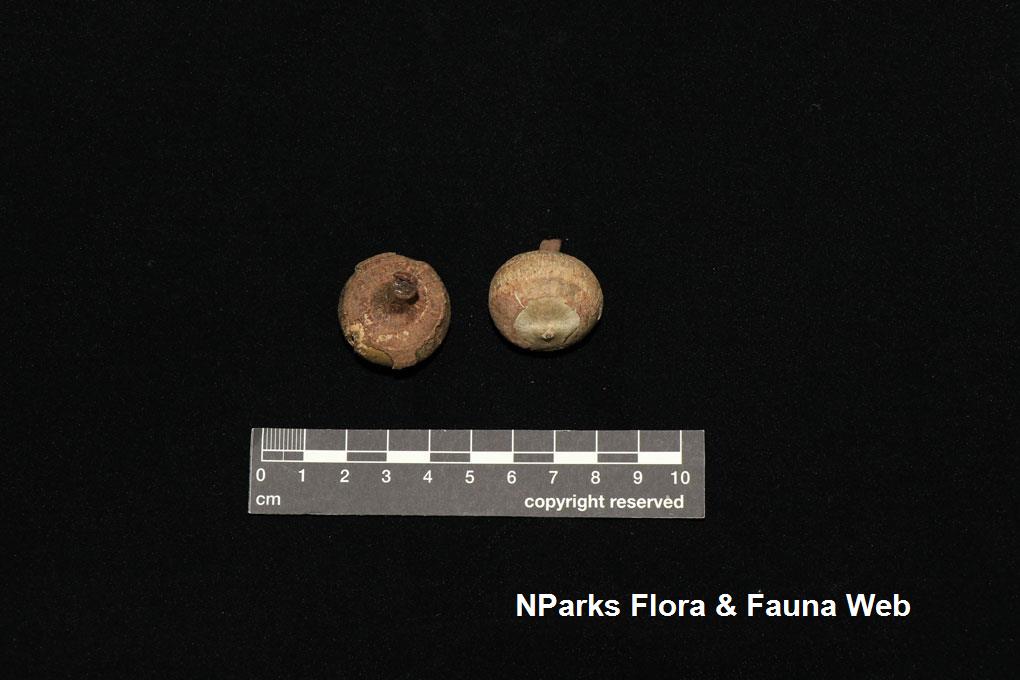
Back
Lithocarpus elegans (Blume) Hatus. ex Soepadmo
| Family Name: | Fagaceae |
| Synonyms: | Quercus elegans |
| Common Name: | Spike Oak, Berangan Landak, Berangan Padi, Empening Gajah, Kelempening, Mempening Bangkas, Mesekam |
Name
Classifications and Characteristics
| Plant Division | Angiosperms (Flowering Seed Plants) (Dicotyledon) |
|---|---|
| Plant Growth Form | Tree (Medium (16m-30m)) |
| Lifespan (in Singapore) | Perennial |
| Mode of Nutrition | Autotrophic |
| Plant Shape | Irregular |
| Maximum Height | 30 m |
Biogeography
| Native Distribution | Pakistan, India, Myanmar, Vietnam, Sumatra, Peninsular Malaysia, Singapore, Borneo, Java, and Sulawesi |
|---|---|
| Native Habitat | Terrestrial (Primary Rainforest, Freshwater Swamp Forest) |
| Preferred Climate Zone | Tropical |
| Local Conservation Status | Native to Singapore (Critically Endangered (CR)) |
Description and Ethnobotany
| Growth Form | It is a tree up to about 30 m tall. Its greyish brown bark is deeply fissured and covered with lenticels. |
|---|---|
| Foliage | Its spirally arranged, stalked leaves have thickly leathery leaf blades that are elongate oval, 12–17 by 4–6 cm, and hairless and glossy above. |
| Flowers | Its male flowering shoots are 10–30 cm long, whereas the bisexual flowering shoots are 15–30 cm long. Its male flowers grow in clusters of 7–15, while the female flowers are in clusters of 5–7. |
| Fruit | Its hairless fruits are ovoid-conical to depressed ovoid-globose, and 1.5–2 cm long. Its cup- to saucer-shaped cupules are 0.5–1 cm long, and densely covered with dull brownish yellow hair. The cupules may or may not be stalked. |
| Habitat | It grows in forests up to 2,400 m altitude. It occurs locally in the Upper Pierce Reservoir area. |
| Associated Fauna | Its flowers are insect-pollinated. |
| Cultivation | It can be propagated by seed. |
| Etymology | Greek lithos, stone, Greek karpos, fruit, referring to the hard acorn; Latin elegans, elegant, referring to the species’ growth form |
| Ethnobotanical Uses | Edible Plant Parts : Edible Fruits Timber & Products: It is a source of timber. Its bark contains tannin. |
Landscaping Features
| Landscaping | It is suitable for planting in parks and large gardens. |
|---|---|
| Desirable Plant Features | Ornamental Fruits |
| Landscape Uses | General, Parks & Gardens |
Fauna, Pollination and Dispersal
| Pollination Method(s) | Biotic (Fauna) |
|---|---|
| Seed or Spore Dispersal | Biotic (Fauna), Abiotic |
Plant Care and Propagation
| Light Preference | Full Sun, Semi-Shade |
|---|---|
| Water Preference | Moderate Water |
| Plant Growth Rate | Moderate |
| Rootzone Tolerance | Moist Soils, Well-Drained Soils, Fertile Loamy Soils |
| Maintenance Requirements | Moderate |
| Propagation Method | Seed |
Foliar
| Foliage Retention | Evergreen |
|---|---|
| Mature Foliage Colour(s) | Green |
| Mature Foliage Texture(s) | Leathery, Thick |
| Foliar Type | Simple / Unifoliate |
| Foliar Arrangement Along Stem | Alternate |
| Foliar Attachment to Stem | Petiolate |
| Foliar Shape(s) | Non-Palm Foliage |
| Foliar Venation | Pinnate / Net |
| Foliar Margin | Entire |
| Leaf Area Index (LAI) for Green Plot Ratio | 3.0 (Tree - Intermediate Canopy) |
Floral (Angiosperm)
| Flower & Plant Sexuality | Unisexual Flowers , Monoecious |
| Flower Colour(s) | Cream / Off-White |
|---|
| Flower Grouping | Cluster / Inflorescence |
Fruit, Seed and Spore
| Mature Fruit Colour(s) | Brown |
|---|---|
| Fruit Classification | Simple Fruit |
| Fruit Type | Indehiscent Dry Fruit , Nut / Nutlet |
Image Repository
Others
| Master ID | 1706 |
|---|---|
| Species ID | 2999 |
| Flora Disclaimer | The information in this website has been compiled from reliable sources, such as reference works on medicinal plants. It is not a substitute for medical advice or treatment and NParks does not purport to provide any medical advice. Readers should always consult his/her physician before using or consuming a plant for medicinal purposes. |




